
Our modern lives are hectic and demanding. Add in lifestyle changes caused by the pandemic—like remote and hybrid work—and we are all feeling increased levels of stress. More than half of us admit to feeling burned out at work, a significant jump from recent years. What's going on with burnout and how can we combat it?
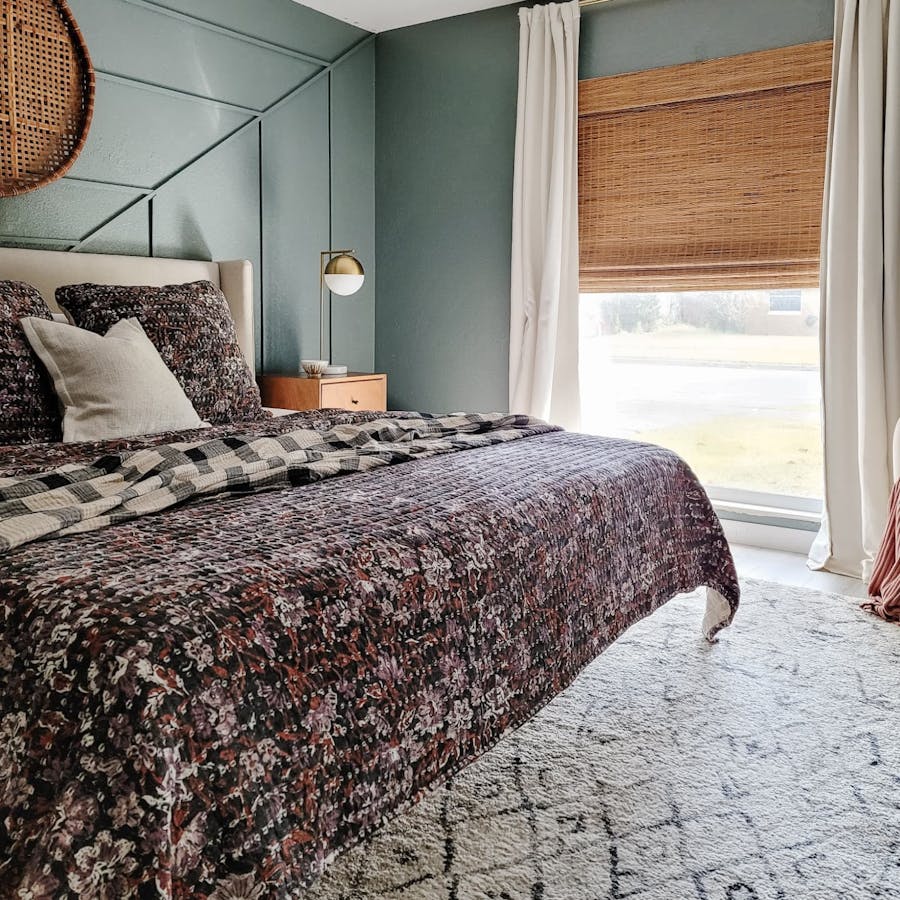
Pictured: SouthSeas Woven Wood Shade in York Pine. Photo via: @houseof.lais.
Burnout stems from stress, and it leaves us overwhelmed and emotionally drained. The good news? Lifestyle changes can help people recover. Experts say these are the top changes to make:
- Get enough quality sleep
- Ensure you have enough downtime for relaxation
- Take time to connect with your community
Of course, that's easier said than done! Americans stay digitally connected during all waking hours, stretching the workday to new lengths. According to Dr. Pradeep Bollu, a board-certified sleep specialist and neurologist with Prisma Health Neurology in Columbia, SC, this is one of the biggest mistakes one can make.

Pictured: Cordless Woven Wood Shade in Aruba raffia. Pictured: @quintessential.home.
"People assume that they don't need all the eight to nine hours of sleep their body demands, and they try to find ways to maximize their daytime and cut down on their sleep time," says Dr. Bollu. "There is no artificial or natural substitute to sleep. If you get into sleep debt—becoming deprived of sleep, intentionally or unintentionally—you need to pay it back by taking extra sleep time."
Nationwide, people are concerned about sleep. In fact, Google Trends shows a significant increase over the past 19 years in sleep topic interest.
To note, 100 is peak popularity for the term – and in January and February of 2023, Sleep topics are at 100 – the maximum and highest since 2004:

Interestingly, Google Trends also shows that searches for tracking sleep have been on the rise. From standalone apps to wearables like Apple Watches and Fitbits, more and more of us are interested in using technology to track our sleep. While wearables and apps aren't yet good enough to diagnose sleep disorders, experts say sleep trackers can give you a sense of how much sleep you're getting and help you improve your sleep habits.
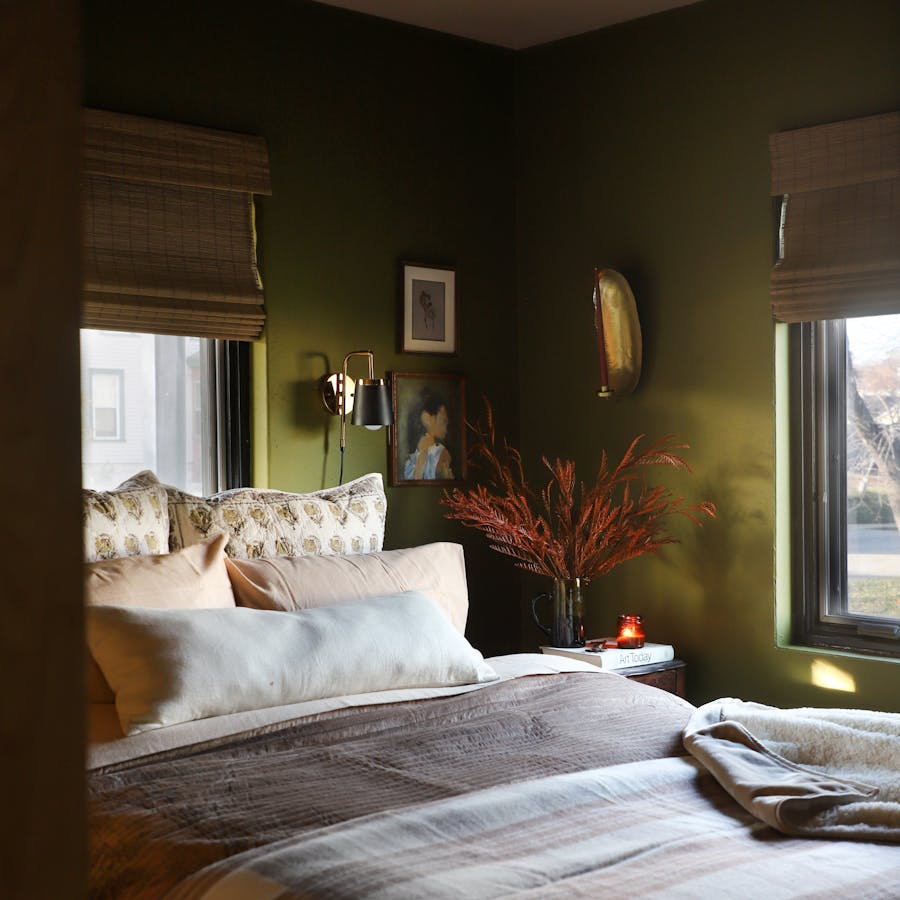
Pictured: Motorized Woven Wood Shades in Rustic Tan. Photo via: @ispydiy.
Google Trends shows that interest in sleep tracking is concentrated in the Upper Midwest and Pacific Northwest states, which also tend to be the states where people are sleeping better.

Sleep Helps Reduce Burnout Risk: How Much Are People Getting in Your State?
Tracking your sleep and being well-rested might go hand in hand. Interest in sleep tracking is highest in many of the states that get the longest nights of sleep.
Six of the top ten states where the search volume for "sleep tracking" is the highest are also among the states that get the most amount of sleep: Minnesota, Colorado, Washington, Idaho, Nebraska, and Oregon. Have they cracked the code to better sleep?

Colorado residents report that they get the most amount of sleep per night. Of the top ten states with the longest sleep time, eight are in the Upper Midwest and Northwest.
The most states with the shortest average sleep time are in the South. West Virginians are most likely to sleep less than seven hours per night, the recommended minimum amount of sleep for adults:
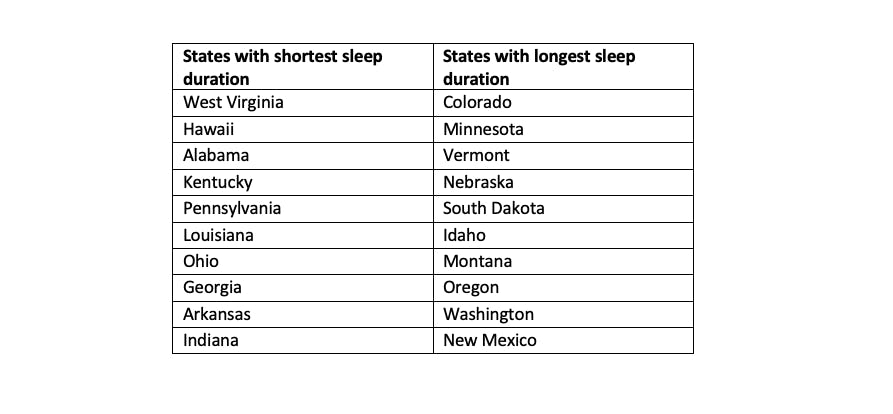
In areas of the country that experience long summer days with early sunrises, people have improved their sleep quality by installing blackout blinds and shades. The areas of the country that get the least sleep should take note—whether it's blocking light and noise or painting walls to be a more relaxing hue, creating a home environment that fosters serenity and sound sleep is a key step toward warding off burnout.
6 Steps to Improve Your Home, Get Better Sleep, and Ward Off Burnout
How do you go from busy-until-the-wee-hours to getting eight hours of sleep each day? Start the transition by ensuring your home is a conducive environment for respite. Strategic updates to the rooms where you lay your head can help you get to sleep faster and wake up feeling more refreshed.
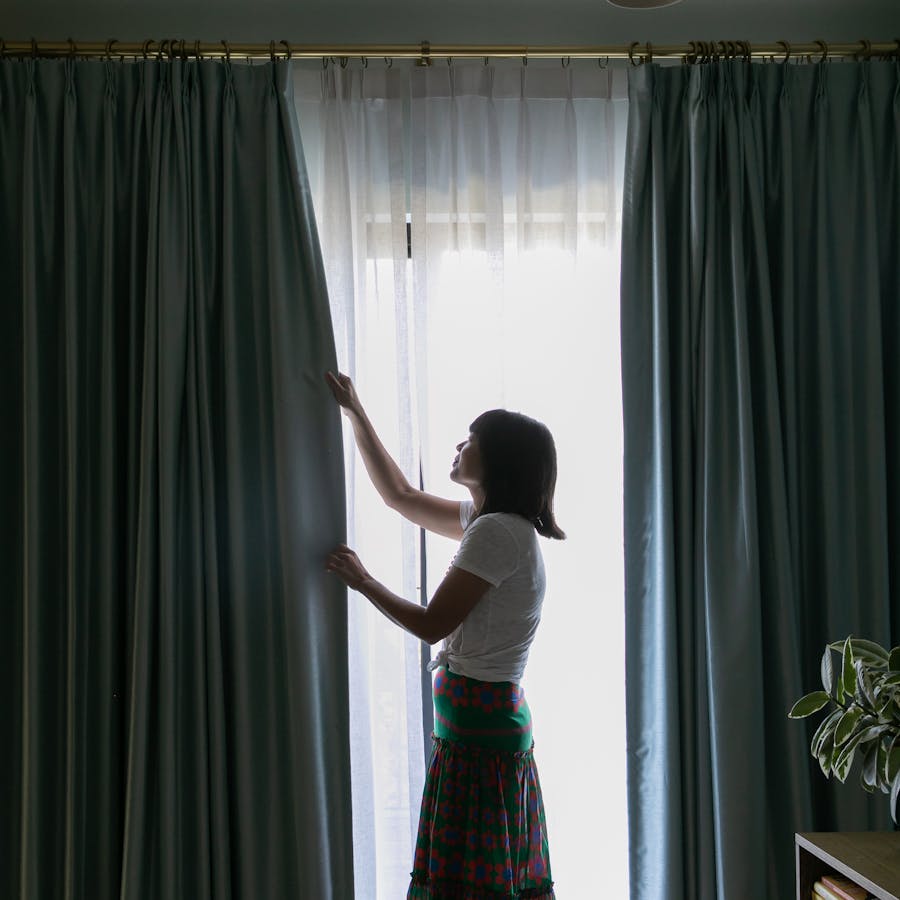
Pictured: French Pleat Drapery in Celene Ivory & Easy Classic Pleat Drapery in Helena Ice. Photo via: @ohjoy.
1. Darken Your Sleeping Space Completely
Light exposure affects sleep quality, so it’s it's important to regulate the light in your home. Darkness is key to reaching a peaceful state that leads to restful sleep.

Pictured: Classic Blackout Roller Shade in Verona Onyx.
"Sunlight is one of the strongest influencers of our sleep rhythms,” says Dr. Bollu. “"Our inner sleep drive is weakened by the sunlight. A lack of sunlight lets our inner sleep drive take over to put us to sleep."
That may be precisely why blackout window treatments are so popular in states like Alaska, Montana, Maine and the Dakotas, according to customer purchase data from Blinds.com. Danielle Sansone, a senior design consultant at Blinds.com, says that clients from Alaska almost always order blackout shades. “"They have so much sunlight in the summer, it's the only way to get restful sleep," says Sansone. "[In general], the further north I go, like Montana and North Dakota, those states will tend to get blackout shades."
With so many new options, motorized blinds and shades can also be a good alternative for getting the quality sleep you need. Remote-controlled options allow easy access to window treatments on oversized or hard-to-reach windows or let the sunlight in when you wake up without leaving the comfort of your bed. Some can even be connected to your smart devices for even more convenience and light control.

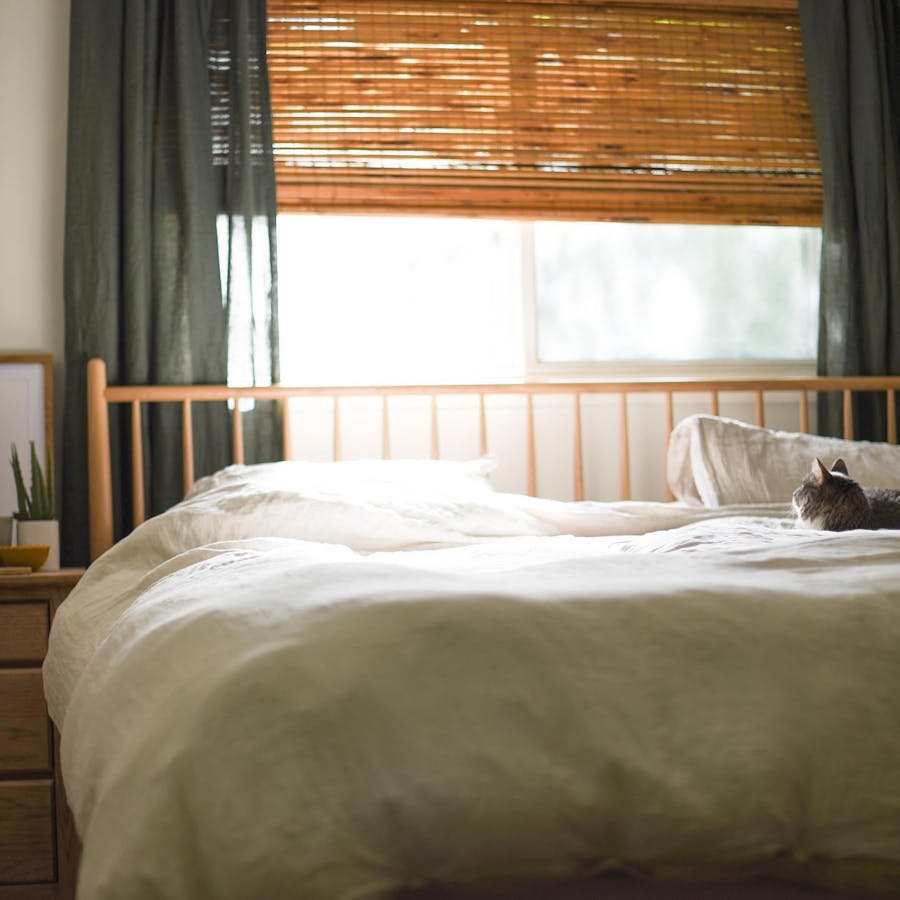
Pictured: Cordless Woven Wood Shade in Hatteras Camel. Photo via: @katie.conley.
Here are four steps you can take to ensure you create a truly dark room:
- Consider all light sources. Make sure windows are covered appropriately to reduce light during sleep hours. That doesn't just mean sunlight, emphasizes Steph DeWaegeneer, a design consultant for Blinds.com. "Clients will call in and say that for two years, they've been aggravated by the streetlamp outside. Or, because of the position of their house, they have headlights shining in. There are all kinds of distractions that people don't necessarily think of."
- Determine where you need coverage. The bedroom may not be the only room that needs blackout window treatments. Outside light can enter your sleeping area from adjacent hallways, bathrooms and even the living room. There are options for people who want to block out light but who don't want to sacrifice their view. "I look at pictures of the whole house on a real estate site like Zillow to get a full understanding of the light situation to help customers block light from adjoining spaces," says Sansone.
- Find the best coverage for your home. For existing blinds that cover most of the window but have gaps around the side, it may be possible to retrofit them with a light gap blocker. These are designed to block out ambient light that leaks in around the sides of shades.
Get the right fit. Precise measurements are critical to ensuring shades fit tight to the sides of the window and block as much light as possible. The old adage says to measure twice and cut once, but when it comes to measuring windows, it may be best to have a professional do the measuring if you're serious about room darkening. It's one less thing for your to-do list, and delegating challenging tasks to an expert can help reduce stress.
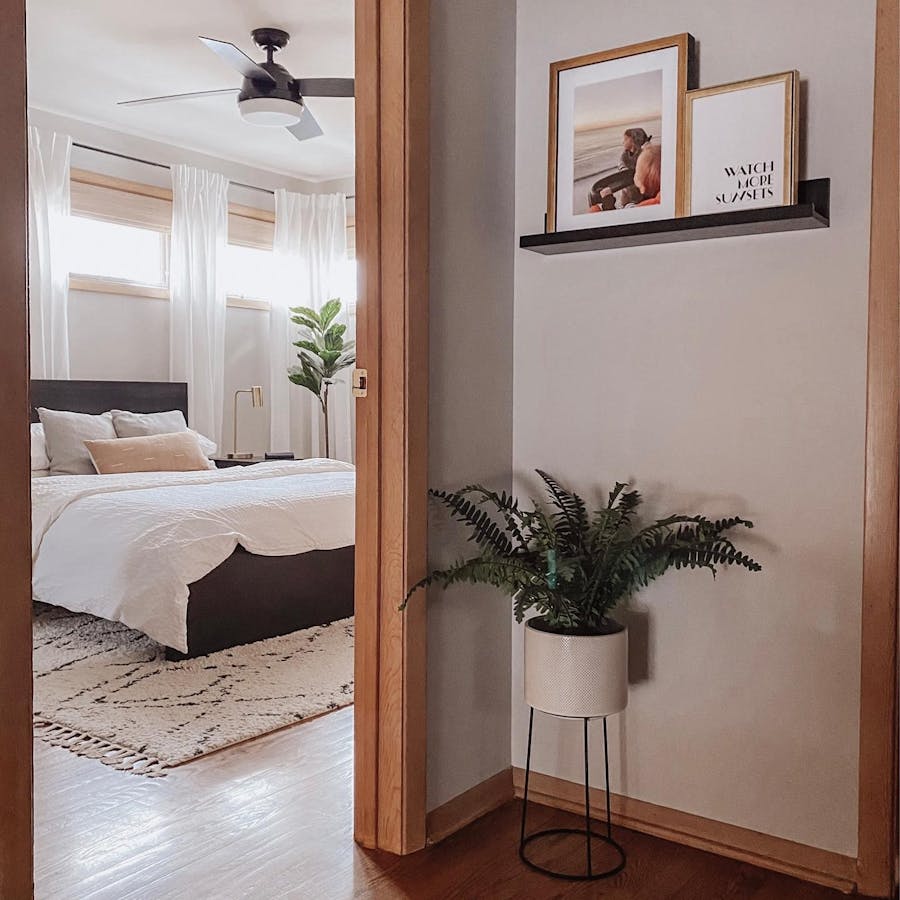
Pictured: Woven Wood Shade in Capri Ivory. Photo via: @stefaniejean_.
2. Turn Off Devices, Especially Those with Blue Light
Exposure to light also plays other roles in your sleep patterns. According to Dr. Bollu, it's important to minimize exposure to light before bedtime. "Avoid TV and electronic gadgets before bedtime," says Bollu. "Avoid 'daylight' lamps and use warm temperature lamps, especially at bedtime."
Why? Exposure to any light can suppress the secretion of melatonin, a hormone that influences your internal body clock (aka circadian rhythms). But blue light, which is given off by electronics, does so more powerfully when it's absorbed in an otherwise dark environment. A University of Haifa study [SB1] found that after exposure to red light, people woke up an average of 4.5 times. Following exposure to weak blue light, 6.7 awakenings were recorded, rising to as many as 7.6 awakenings, on average, following exposure to strong blue light.
In addition to avoiding bright screens two to three hours before bed, protect yourself from blue light by:
- Exposing yourself to as much bright light during the day as possible to bolster your circadian rhythm. It will improve your sleep at night and your mood and alertness during the daytime.
- Using dim red lights for night lights; they're the least disruptive to sleep.
- Wearing a sleep mask to limit all light, including blue light.
- If you work a night shift or must use electronic devices at night, consider wearing blue-blocking or amber-tinted glasses. Or, use an app on your devices to filter blue light at night.
3. Keep Cool

Pictured: Levolor Roman Shade in Seclusions Light Gray. Photo via: @littlecottageonthecoast.
Your body temperature drops in order to initiate sleep. Keeping your room temperature between 60 and 67 degrees can help your body shift into sleep mode. Energy. gov[SB1] suggests cellular shades to help with both heating and cooling:
- When it's cold, approximately one-third of a home's heating energy is lost through its windows. Cellular shades, which have high R-values to resist conductive heat transfer, can reduce heat loss by 40 percent or more if there's a tight fit.
- When it's hot, about three-quarters of the sunlight that touches standard double-pane windows enters your home. Cellular shades can reduce solar heat through windows by up to 80 percent when installed with a tight seal to the window frame.
States where customers invest in cellular shades also align with the states that most frequently purchase blackout window coverings: Alaska, Vermont and Montana. They're joined in the top five by Northeastern states with cold winters, like Maine and New Hampshire.

Automating your window coverings can also help with keeping your room cool. Sansone recommends setting shades on a timer to have them automatically come down and help cool the room before your bedtime. With your smart home device, you can even have the shades open automatically if the house reaches a certain temperature.
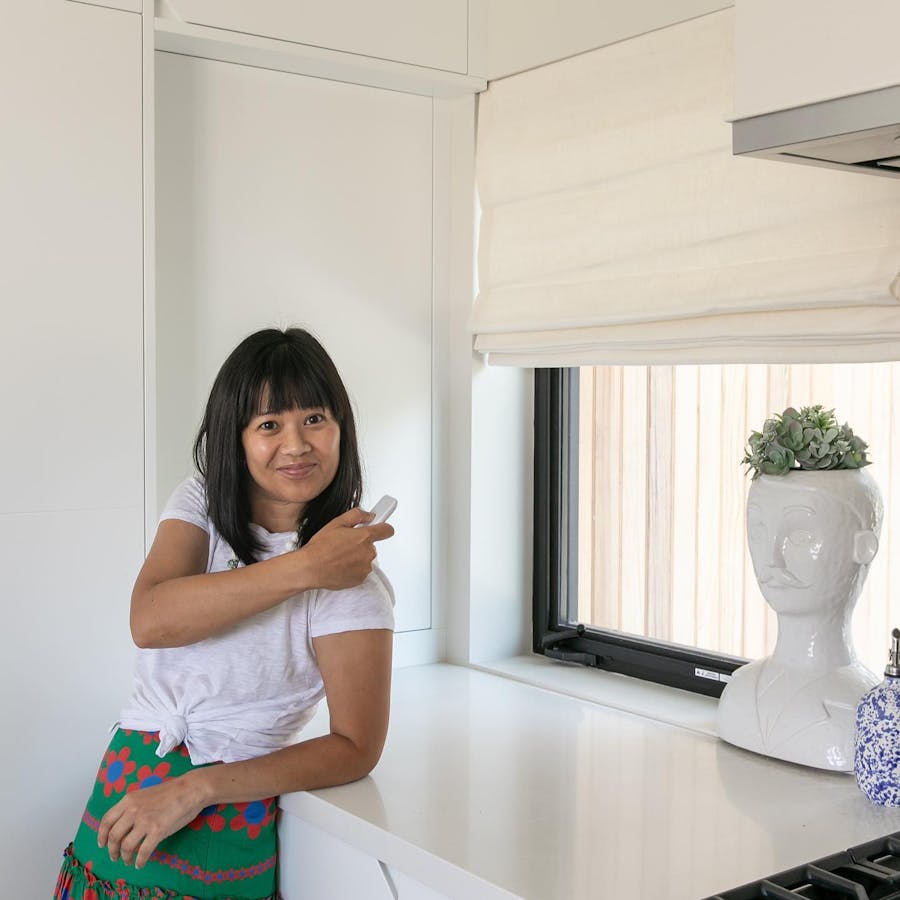
Pictured: Motorized Premium Roman Shades in Gent Bisque. Photo via: @ohjoy.
4. Reduce Noise

Pictured: Bali Natural Woven Wood Shade in Antigua Bahia. Photo via: @the_cobblestone_farmhouse.
We're able to sleep through familiar sounds, but unexpected noises can stir us from our slumber. Noise is more likely to wake you from a light sleep than from a deep sleep. It also tends to be more disturbing in the second half of the night, and when the noise has some sort of emotional relevance to you. This explains how a parent can sleep soundly through their partner's snoring but be fully awake when their baby moves.
Some noise-reducing tips to consider, whether you’re you're a deep or light sleeper:
- If you have a smart device, like an Amazon Echo or Google Home, ask it to "play ambient noise all night." Or use a white-noise machine, a fan or an air purifier.
- Earplugs can be helpful for light sleepers or in settings where there is a lot of ambient noise, like an apartment building on a busy street.
- Position your bed as far as possible from windows and thin walls.
Window treatments can also block noise, depending on the style and correct installation. "Sometimes customers in urban locations, like people moving into urban condos, want to block some of that city noise. We often help find window treatments, like cellular shades, that do that," says DeWaegeneer.
5. Declutter and Simplify Your Surroundings
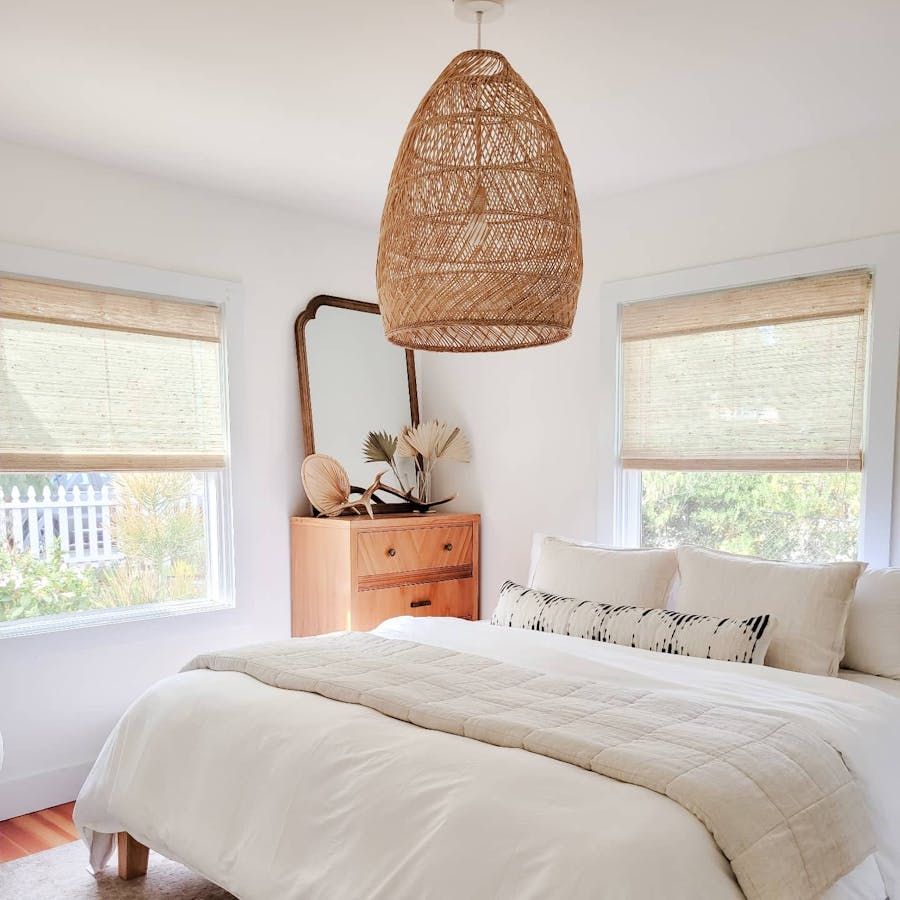
Pictured: SouthSeas Woven Wood Shade in Bonaire Flaxen. Photo via: @acoastalcasita.
If the popularity of #CleanTok videos on TikTok is any indication, we love watching cleaning and decluttering videos. Indeed, #cleantok has garnered more than 65 billion views, and the content creators behind those videos love to show us how they clean and organize their drawers, scrub down their showers, and generally improve their homes through cleaning and organization.
Organizing your space has many benefits, including reducing stress. A study by the University of California, Los Angeles, found that married women living in what they perceived as messy houses had higher levels of cortisol, a stress hormone, when compared with those who felt that their homes were neat.
Clutter can even make us more likely to reach for junk food. Participants of another study who have a "chaotic kitchen" ate twice as many cookies as those in an organized kitchen.
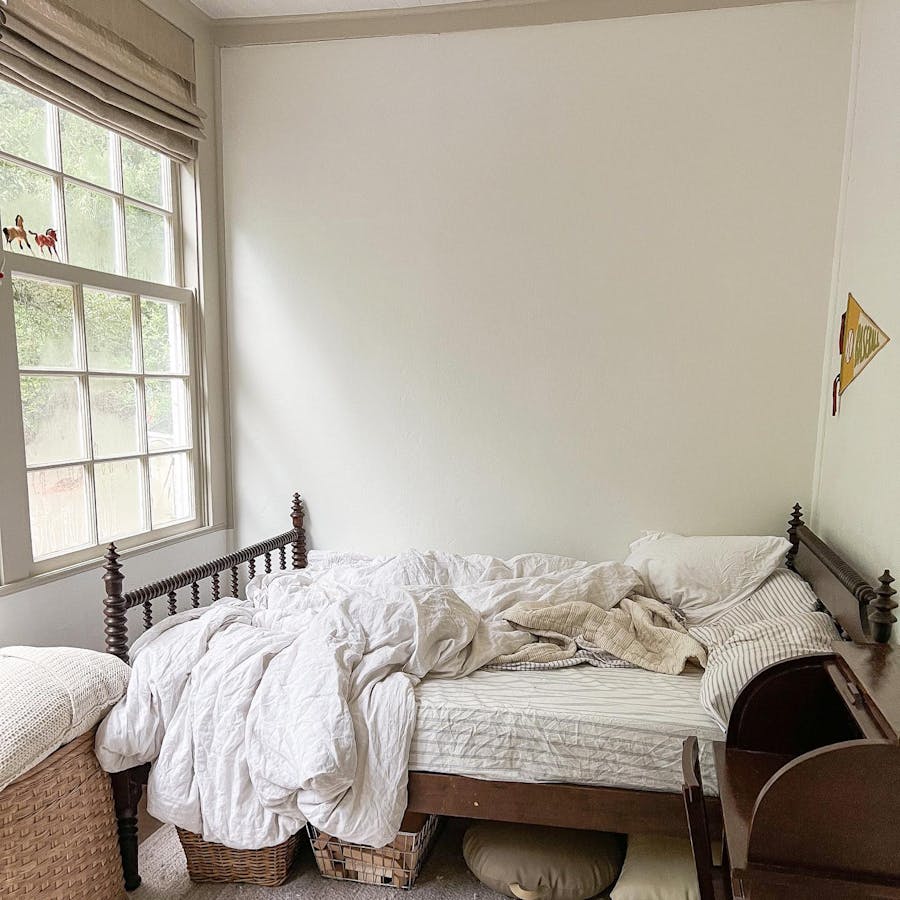
Pictured: Premier Cordless Roman Shade in Sussex Flax. Photo via: @happinessisahomestead.
DeWaegeneer recommends keeping your décor and accessories minimal. "You don't want to be overwhelmed when you walk into your bedroom with a lot of clutter. That's not just laundry piles, but also having every knickknack you own on display. It's about paring it down and minimizing it."
Simplifying is not only about your home environment. It's also about asking for help and leaning on experts for support. Take advantage of services when they're available and affordable—–and you don't have real skills or background—–to help relieve stress. Using pros also allows you to make progress on home projects quickly and efficiently, without worrying about whether you're doing it correctly or may lose steam or focus along the way.
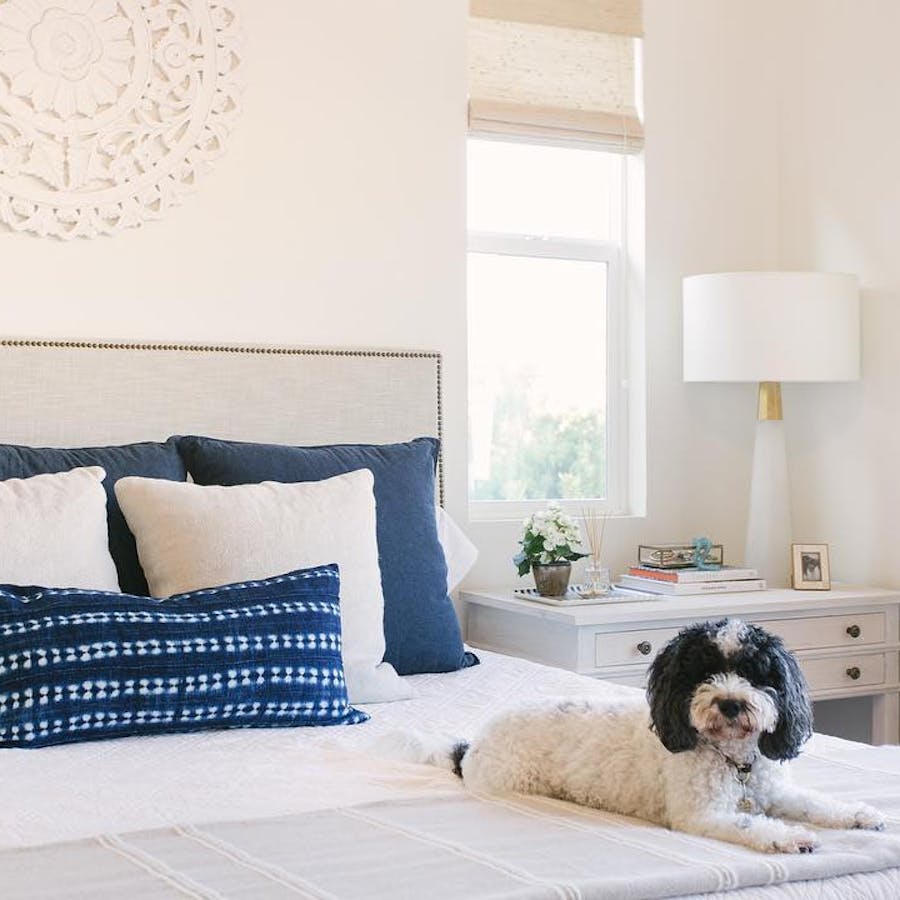
Pictured: Woven Wood Shade in Rustic Jute. Photo via: @madisonnicoledesign.
6. Choose Soothing, Cool Colors and Soft Finishes
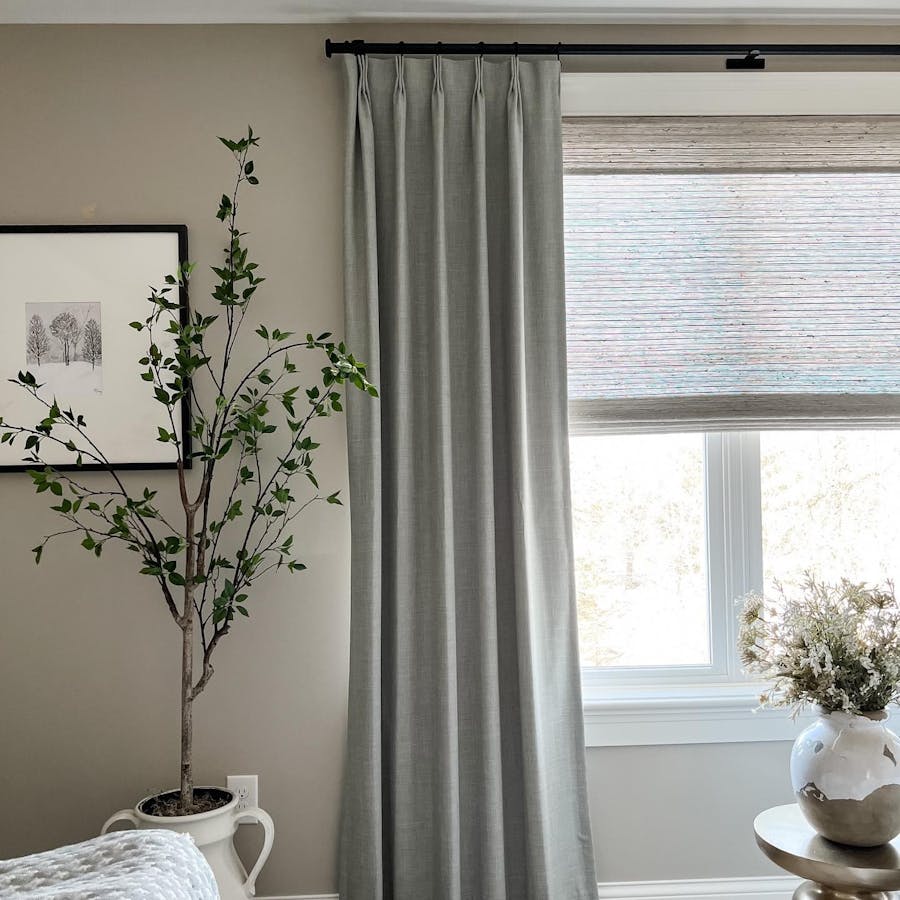
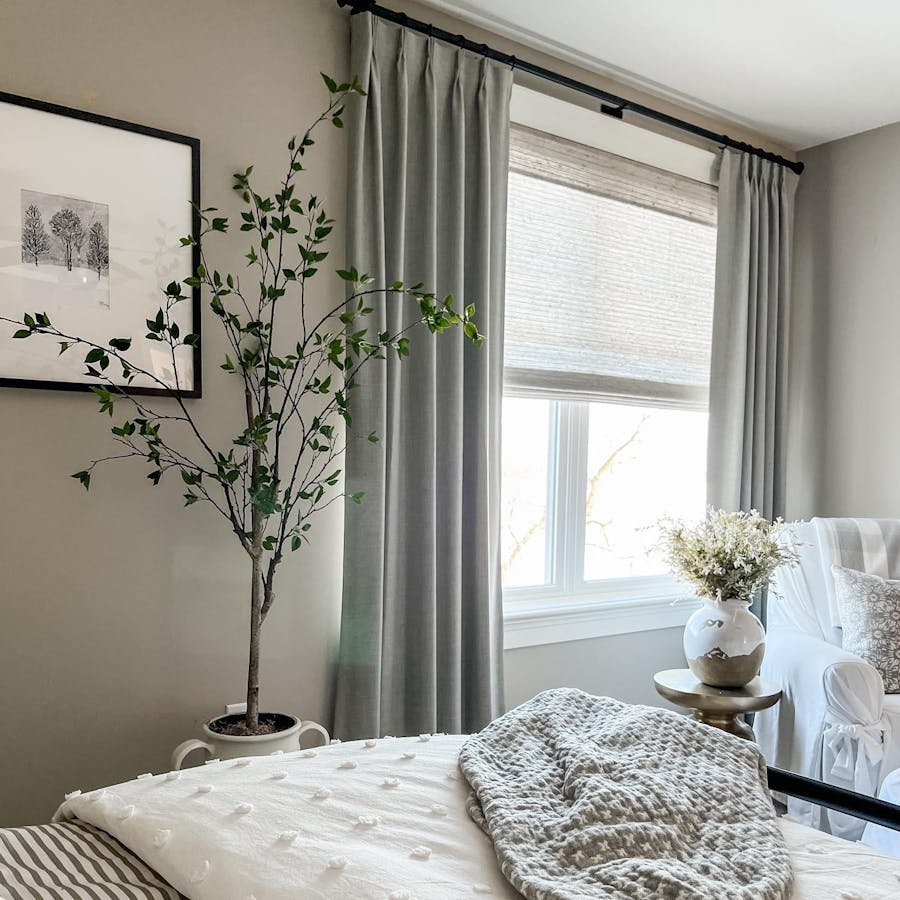
Pictured: Easy Classic Pleat Drapery in Rio Stone & Woven Wood Shade in Bennett Mist. Photos via: @tuxedofarmhouse.
People who paint their room blue tend to sleep longer than those with different color choices, according to a study by Travelodge. The color blue is associated with feelings of calm, which helps reduce blood pressure and heart rate to help you get a solid night's sleep.
If blue isn't for you, keep your bedroom wall color relaxing and cool with light shades of green, gray or silver, as well as muted neutral tones. Avoid purples, reds and bright whites, as they tend to stimulate the brain and may even cause vivid dreams or nightmares. Dark browns and grays may feel gloomy, so avoid those, too.
"Choosing the correct color is key," says Sansone. "Whenever you're setting up your home environment, choose lighter, more relaxing colors. Off shades of white, light greys, blues, greens: those more serene colors. Once you get into bolder, more saturated colors, they activate brain activity."
When selecting décor to improve sleep, consider these additional tips:
- Make sure your mattress is in good condition and allows you to sink into a deep, natural sleep and wake up in the morning without aches and pains. Your mattress shouldn't be too lumpy, hard, or soft.
- Cover your bed with silky, natural tree-fiber sheets in a soothing color, to keep you cool and limit friction when you change position.
- Add texture, rather than bold patterns and bright colors, to bring interest to your room. Think about tassels, faux fur, boucle fabrics, pom poms, and velvet. And, add a plant or two. They reduce stress and can help purify the air.
Get Started Now
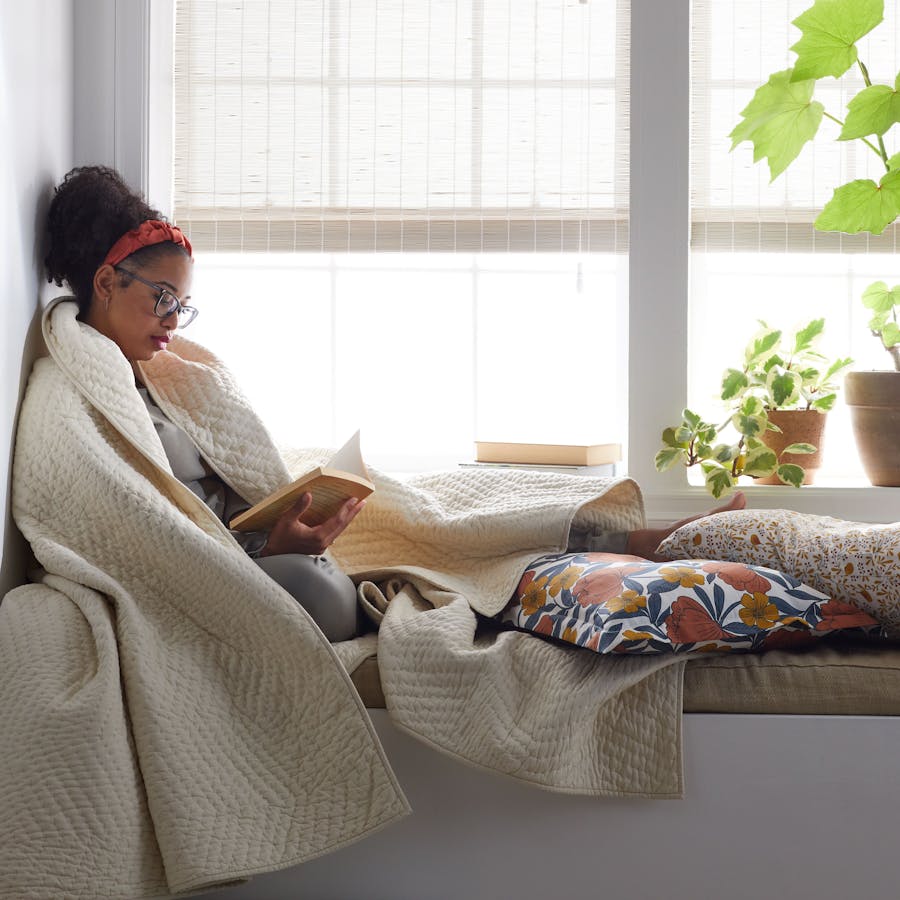
Pictured: Woven Wood Shade in Rustic Jute.
The best way to deal with burnout is to prevent it. But for people already suffering, it's possible to change how you feel and function.
DeWaegeneer suggests creating a nightly routine. Her ritual: "Shut down the lights, lock the door, give the dog a treat, pour a water, put on lotion, use some lavender linen spray to help relax." Your routine can include whatever helps you shut down to tell your body it's time to sleep.
Just as burnout doesn't happen overnight, you might not be able to make all these changes in a single day. Start with a few small steps, like powering down your phone early and using a fan to cool your room and create some white noise. Then, take the next steps to improve your home spaces so you can sleep better— especially if you live in a region prone to high stress and less sleep. Hire experts to help when you need them. The journey shouldn't be stressful —– take time to reach your goal of a healthy, pared-down space that will help you get the sleep your body needs.
And, of course, if your burnout is more severe, “"Speak up," says Dr. Bollu. “"Talk to someone about your feeling of no longer finding joy in what you do. Seek help in identifying the factors that put you in this state in the first place. Figure out solutions to address those factors to get back on track."
Are you on the verge of burnout? What your home says.
Symptoms of burnout include fatigue, withdrawal and cynicism, but it can often be hard to recognize these warning signs in yourself. However, there may be indicators around your home that you're entering pre-burnout. Here are four things to look for:
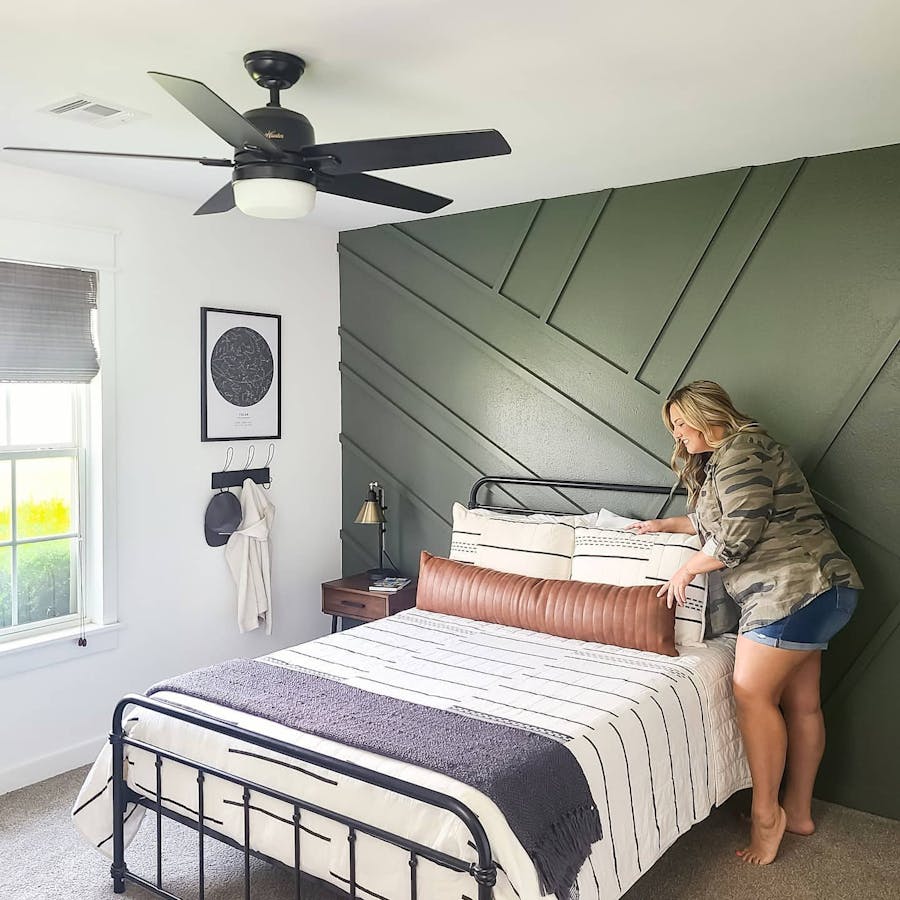
Pictured: Bali Natural Woven Wood Shade in Antigua Bahia with a blackout liner. Photo via: @the_cobblestone_farmhouse.
- Disorganization and clutter. Physical clutter is frequently a sign of mental clutter. With so much on your plate, it's easy to let home organization slip.
- Junk food. When life gets hectic, it's easy to cut corners and skip cooking. Check out what's in your fridge; is it consistent with a healthy mix of foods? Or is it full of take-out containers and more beer or wine than usual?
- Partially complete projects. Motivation becomes a challenge when you're burned out. Tasks that seemed like a good idea a month ago now feel daunting. That room you half painted half of or the afghan you started to crochet but didn't finish could be pointing toward an inability to stay inspired.
- You're home more frequently. People experiencing burnout tend to withdraw and prefer to be alone. If you're turning down activities and spending more time by yourself, that could be a cue you're experiencing symptoms of burnout.
If you think you're at risk of burning out, there are lots of ways to get help. The Mayo Clinic offers some additional advice for identifying burnout and taking action.
